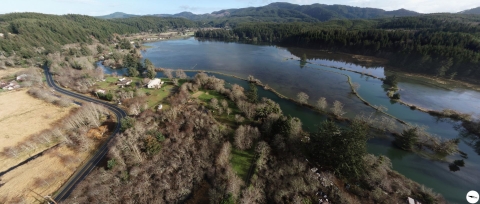Environmental Assessment for the Lower Drift Creek Tidal Marsh Restoration
The U.S. Fish and Wildlife Service (Service) released the final Environmental Assessment (EA) on a project that will restore estuarine habitat in the Drift Creek Unit of the Siletz Bay National Wildlife Refuge (NWR). The document is available for download at the bottom of this page.
A public meeting took place on March 9, 2023. The meeting was an opportunity for the public to learn more about the proposed restoration.
Project Background
The Service’s project will restore 74 acres of tidal wetlands on three tracts of land along a portion of Drift Creek that is part of Siletz Bay NWR. The project will improve habitat for anadromous fish including threatened coho salmon, migratory birds, and a diverse array of other native fish and wildlife and reduced impacts of flooding on adjacent public infrastructure and private residences. Actions under this proposal include dike removal; realignment of drainage ditches and initiation of primary, secondary, and tertiary tidal channels; placement of wood habitat structures; removal of channel obstructions; creation of topographic diversity; control of invasive plant species; and planting and seeding to restore native vegetation. The proposed actions will only occur on Refuge lands.
Drift Creek is a tributary to the Siletz basin. It provides important spawning and rearing habitat for native salmonids and has populations of chinook and coho salmon, winter steelhead and cutthroat trout. Populations of these and other species have been significantly reduced over the past 60 years, because of levee construction, ditching, timber harvest, road construction and other activities. These land practices have impacted floodplain connectivity, resulting in barriers to fish rearing habitat as well as hydrologic constrictions which impact flooding.
Since 2019, the Service and its partners including the MidCoast Watersheds Council, Salmon Drift Creek Watershed Council, Wolf Water Resources, and the Confederated Tribes of Siletz Indians have worked with private landowners and other stakeholders to identify habitat restoration projects within the Lower Drift Creek area. They gathered public input, collected biological data, and utilized an engineering analysis to evaluate alternatives for improving estuarine habitat to benefit anadromous fish and migratory birds while reducing the impacts of flooding on adjacent public infrastructure and private residences. Using this information, the Service has prepared the final EA to evaluate effects and alternatives for this proposed project.
Public Comments on the Draft EA
The comment period for the draft EA ended on March 30, 2023.
The Service has evaluated and responded to the comments received and informed the public of our decision. A proposed action is often iterative and may evolve during the process as the Service refines its proposed action and gathers feedback from the public, tribes, and other agencies. Therefore, the final proposed action may include changes from the original.





